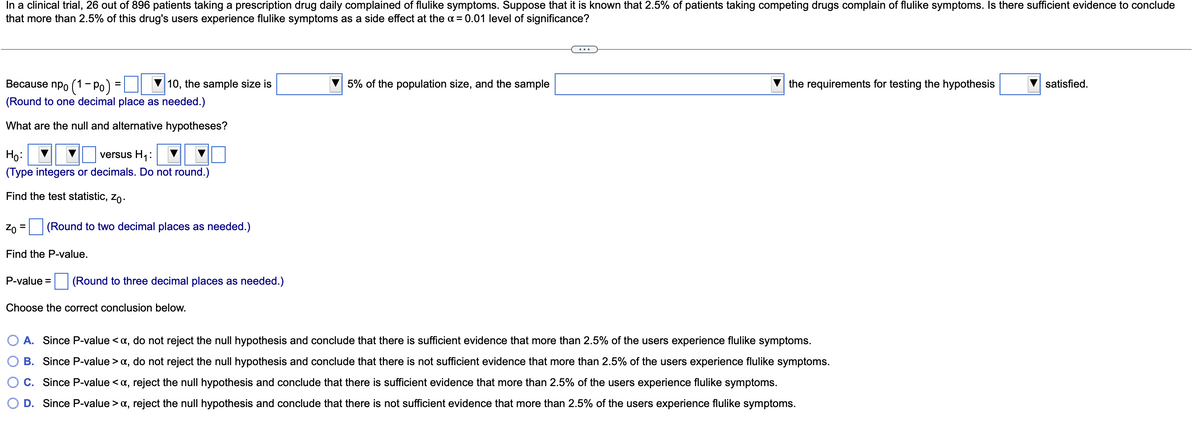In a clinical trial, 26 out of 896 patients taking a prescription drug daily complained of flulike symptoms. Suppose that it is known that 2.5% of patients taking competing drugs complain of flulike symptoms. Is there sufficient evidence to conclud that more than 2.5% of this drug's users experience flulike symptoms as a side effect at the a = 0.01 level of significance? Because npo (1- Po) =O 10, the sample size is (Round to one decimal place as needed.) V 5% of the population size, and the sample the requirements for testing the hypothesis V satisfied. What are the null and alternative hypotheses? versus H, Họ: (Type integers or decimals. Do not round.) Find the test statistic, zo. Z0 = (Round to two decimal places as needed.) Find the P-value. P-value = (Round to three decimal places as needed.) Choose the correct conclusion below. O A. Since P-value a, do not reject the null hypothesis and conclude that there is not sufficient evidence that more than 2.5% of the users experience flulike symptoms. O C. Since P-value a, reject the null hypothesis and conclude that there is not sufficient evidence that more than 2.5% of the users experience flulike symptoms.
In a clinical trial, 26 out of 896 patients taking a prescription drug daily complained of flulike symptoms. Suppose that it is known that 2.5% of patients taking competing drugs complain of flulike symptoms. Is there sufficient evidence to conclud that more than 2.5% of this drug's users experience flulike symptoms as a side effect at the a = 0.01 level of significance? Because npo (1- Po) =O 10, the sample size is (Round to one decimal place as needed.) V 5% of the population size, and the sample the requirements for testing the hypothesis V satisfied. What are the null and alternative hypotheses? versus H, Họ: (Type integers or decimals. Do not round.) Find the test statistic, zo. Z0 = (Round to two decimal places as needed.) Find the P-value. P-value = (Round to three decimal places as needed.) Choose the correct conclusion below. O A. Since P-value a, do not reject the null hypothesis and conclude that there is not sufficient evidence that more than 2.5% of the users experience flulike symptoms. O C. Since P-value a, reject the null hypothesis and conclude that there is not sufficient evidence that more than 2.5% of the users experience flulike symptoms.
College Algebra (MindTap Course List)
12th Edition
ISBN:9781305652231
Author:R. David Gustafson, Jeff Hughes
Publisher:R. David Gustafson, Jeff Hughes
Chapter8: Sequences, Series, And Probability
Section8.7: Probability
Problem 58E: What is meant by the sample space of an experiment?
Related questions
Question

Transcribed Image Text:In a clinical trial, 26 out of 896 patients taking a prescription drug daily complained of flulike symptoms. Suppose that it is known that 2.5% of patients taking competing drugs complain of flulike symptoms. Is there sufficient evidence to conclude
that more than 2.5% of this drug's users experience flulike symptoms as a side effect at the a = 0.01 level of significance?
Because npo (1- Po) =
10, the sample size is
5% of the population size, and the sample
the requirements for testing the hypothesis
satisfied.
(Round to one decimal place as needed.)
What are the null and alternative hypotheses?
Ho:
versus H1:
(Type integers or decimals. Do not round.)
Find the test statistic, zo.
Zo
(Round to two decimal places as needed.)
%3D
Find the P-value.
P-value =
(Round to three decimal places as needed.)
Choose the correct conclusion below.
A. Since P-value <a, do not reject the null hypothesis and conclude that there is sufficient evidence that more than 2.5% of the users experience flulike symptoms.
B. Since P-value > a, do not reject the null hypothesis and conclude that there is not sufficient evidence that more than 2.5% of the users experience flulike symptoms.
C. Since P-value <a, reject the null hypothesis and conclude that there is sufficient evidence that more than 2.5% of the users experience flulike symptoms.
D. Since P-value > a, reject the null hypothesis and conclude that there is not sufficient evidence that more than 2.5% of the users experience flulike symptoms.
Expert Solution
This question has been solved!
Explore an expertly crafted, step-by-step solution for a thorough understanding of key concepts.
This is a popular solution!
Trending now
This is a popular solution!
Step by step
Solved in 2 steps

Recommended textbooks for you

College Algebra (MindTap Course List)
Algebra
ISBN:
9781305652231
Author:
R. David Gustafson, Jeff Hughes
Publisher:
Cengage Learning

College Algebra (MindTap Course List)
Algebra
ISBN:
9781305652231
Author:
R. David Gustafson, Jeff Hughes
Publisher:
Cengage Learning